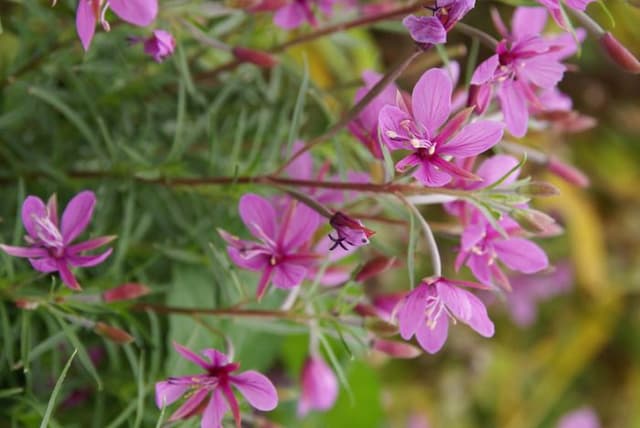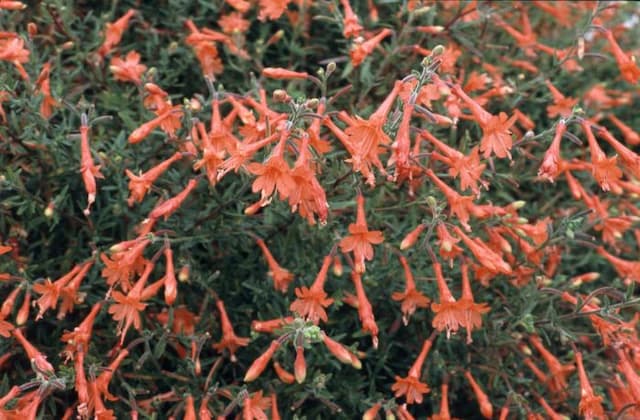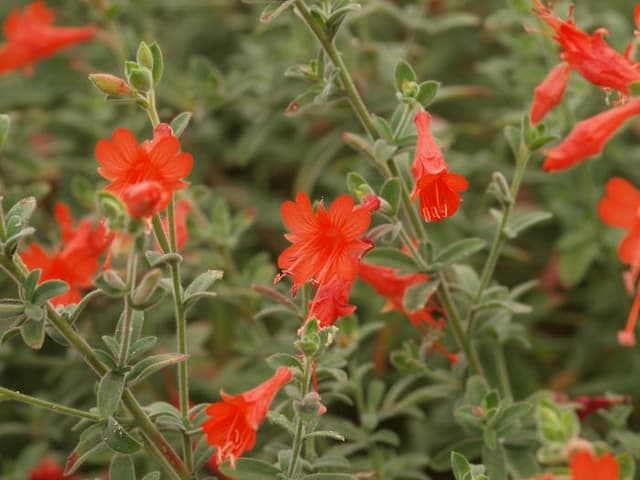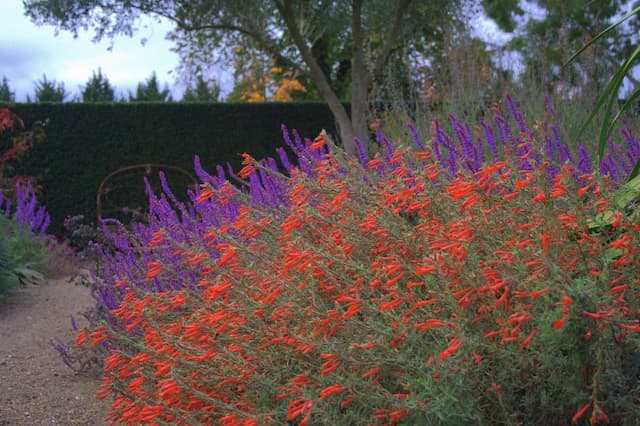Fuchsia Fuchsia 'Suffolk Splendour' (d)

ABOUT
Fuchsia 'Suffolk Splendour' is known for its striking appearance, characterized by its gracefully arching branches bearing profuse, pendulous flowers that are a sight to behold. The blooms display a vibrant contrast with their two-tone colors, typically exhibiting a deep purple corolla – the inner skirt-like part of the flower – enhanced by bright red sepals, which are the outer leaves that encase the bud. These sepals gracefully curve back away from the corolla, adding to the overall elegance of the flower. A distinguishing feature of this variety is the particularly large, showy blooms that dangle artfully from the plant, creating a cascading effect that can be quite mesmerizing. The foliage of the 'Suffolk Splendour' is equally as decorative, with leaves that present a green to dark green color, sometimes with a subtle purple or reddish underside that complements the floral display. These leaves are typically oval-shaped with a slight point at the tip and can have a slightly serrated edge, adding texture to the plant's profile. The juxtaposition of the dark foliage against the vibrancy of the flowers makes for a stunning ornamental display. Taken together, the dramatic flowers and lush foliage make Fuchsia 'Suffolk Splendour' a popular choice for gardeners looking to add a splash of color and visual interest to their gardens, hanging baskets, or patio containers. Its graceful form and striking blossoms create a tropical allure, which can enhance any space with its decorative charm.
About this plant
 Names
NamesSynonyms
Fuchsia, Lady's Eardrops, Hardy Fuchsia
Common names
Fuchsia 'Suffolk Splendour'
 Toxicity
ToxicityTo humans
Fuchsia, including the 'Suffolk Splendour' variety, is generally not considered poisonous to humans. Most species of Fuchsia, including this one, can be grown in gardens without concern for toxicity. In fact, the berry-like fruits of some Fuchsia plants are edible and can be made into jams or eaten raw. However, as with any plant, individual allergic reactions or sensitivities are possible. If ingested in large amounts, plant parts may cause mild stomach upset, but this is not common. It is always advisable to prevent children from eating ornamental plants as a precaution.
To pets
Fuchsia, particularly the 'Suffolk Splendour' variation, is not toxic to pets such as cats and dogs. It is generally safe for pets to be around this plant as it is not known to cause any serious harm if ingested. However, it is always best to discourage pets from eating plants since individual animals might have sensitivities or allergic reactions. In rare cases, ingestion of plant material might lead to mild gastrointestinal upset such as vomiting or diarrhea in some pets, but serious toxicity is highly unlikely.
 Characteristics
CharacteristicsLife cycle
Perennials
Foliage type
Deciduous
Color of leaves
Green
Flower color
Mixed
Height
1-2 feet (30-60 cm)
Spread
1-2 feet (30-60 cm)
Plant type
Shrub
Hardiness zones
9
Native area
Central America South America
Benefits
 General Benefits
General Benefits- Ornamental Appeal: Fuchsia 'Suffolk Splendour' is prized for its exquisite hanging flowers that add a burst of color and elegance to gardens and patios.
- Attracts Pollinators: The vibrant blooms attract bees, butterflies, and other beneficial pollinators, supporting biodiversity in the garden.
- Suitable for Containers: This fuchsia variety is well-suited to container gardening, allowing for ornamental display in small spaces or urban settings.
- Long Blooming Season: Fuchsia 'Suffolk Splendour' has a long flowering period, providing visual interest from late spring through fall.
- Versatile Planting Options: It can be planted in hanging baskets, borders, or as a stand-alone specimen, offering flexibility in garden design.
- Shade Tolerant: Unlike many flowering plants, fuchsia performs well in partially shaded conditions, expanding the options for placement in the garden.
- Easy to Propagate: Fuchsia can be easily propagated from cuttings, making it simple for gardeners to create more plants for their garden or to share.
- Hardy Growth: With proper care, Fuchsia 'Suffolk Splendour' is a relatively hardy plant that can withstand various environmental conditions.
 Medical Properties
Medical PropertiesThis plant is not used for medical purposes.
 Air-purifying Qualities
Air-purifying QualitiesThis plant is not specifically known for air purifying qualities.
 Other Uses
Other Uses- Artistic Inspiration: Fuchsia 'Suffolk Splendour' can be used as a muse for painters and photographers due to its vivid colors and unique flower shape.
- Educational Tool: Gardening enthusiasts and horticultural students can study this cultivar to learn about plant breeding and hybridization techniques.
- Theme Gardens: This plant can be featured in a Victorian-themed garden, as fuchsias were very popular during the Victorian era.
- Fairy Gardens: Its delicate blooms can add a magical touch to a miniature fairy garden setup.
- Wedding Decor: The flowers can be used in wedding arrangements or as part of the table settings for their striking appearance.
- Culinary Decoration: Though not commonly known, fuchsia flowers are edible and can be used as a decorative and colorful garnish in salads and desserts.
- Bonsai: Some gardeners may use Fuchsia 'Suffolk Splendour' for bonsai due to its attractive foliage and flowers.
- Color Therapy: The vibrant colors of the fuchsia plant are believed by some to provide positive energy and can be used in color therapy sessions.
- Photography Projects: Macro photography enthusiasts can use the intricate details of the fuchsia flowers for close-up photography projects.
- Fashion Design: The unique color combination and form of the flowers can inspire fashion designers in creating floral prints and patterns.
Interesting Facts
 Feng Shui
Feng ShuiFuchsia is not used in Feng Shui practice.
 Zodiac Sign Compitability
Zodiac Sign CompitabilityFuchsia is not used in astrology practice.
 Plant Symbolism
Plant Symbolism- Confiding Love: Fuchsias are often associated with confiding love, representing trust and intimacy in a relationship.
- Tastefulness: The elegant shape and vibrant colors of the fuchsia signify good taste and a sense of refinement.
- Amiability: Giving a fuchsia plant is often a gesture of friendliness, indicating an amiable, approachable person.
- Humble Love: Unlike more extravagant flowers, fuchsias suggest a more modest form of love, focused on depth rather than showiness.
 Water
WaterFuchsia 'Suffolk Splendour', commonly known as hardy fuchsia, requires consistent moisture, so it's best to water whenever the top inch of soil feels dry. Generally, this might mean watering about once a week, but this can vary depending on climate and weather conditions. Aim to provide approximately one gallon of water to the plant each week during the growing season, adjusting for rainfall, temperature, and soil type. During hot spells or in exceptionally dry climates, you may need to water more frequently, perhaps every few days. Always avoid over-watering by ensuring that the pot or ground has proper drainage to prevent root rot.
 Light
LightHardy fuchsia thrives in a spot with morning sun and afternoon shade, as intense midday sun can scorch the leaves. Bright, indirect light is ideal, making a location that receives filtered sunlight, such as beneath a tree with dappled shade, suitable for this plant. Avoid deep shade conditions, as too little light can limit flowering and result in a leggy plant.
 Temperature
TemperatureHardy fuchsia prefers moderate temperatures and performs best in conditions between 60 to 70 degrees Fahrenheit. These plants can survive briefly down to 32 degrees Fahrenheit, but freezing temperatures can damage or kill them, so it's important to protect them in winter or bring them indoors if grown in pots. They may tolerate temperatures up to 80 degrees Fahrenheit, but should be shaded and watered adequately in higher heat.
 Pruning
PruningPruning hardy fuchsia is important to encourage bushy growth and enhance flowering. Prune in late winter or early spring before new growth begins, cutting back the previous year's growth to one or two buds on each shoot. Remove any dead or damaged wood, and shape the plant to maintain a compact form. Annual pruning will help maintain plant vigor and promote prolific blooms.
 Cleaning
CleaningAs needed
 Soil
SoilFuchsia 'Suffolk Splendour' prefers a rich, well-draining soil mix with a pH between 6 and 7. A good mix can be made from one part loam, one part peat, and one part sand or perlite. This composition ensures proper drainage while retaining adequate moisture.
 Repotting
RepottingFuchsia 'Suffolk Splendour' should be repotted once a year, preferably during the spring. Younger, rapidly growing plants may need repotting more frequently to avoid becoming root-bound.
 Humidity & Misting
Humidity & MistingFuchsia 'Suffolk Splendour' thrives in moderate to high humidity levels, ideally between 60-70%. They benefit from regular misting or being placed on a pebble tray with water to maintain the ambient humidity around the plant.
 Suitable locations
Suitable locationsIndoor
Place in bright, indirect light and keep soil moist.
Outdoor
Hang in semi-shade, shelter from strong winds.
Hardiness zone
10-11 USDA
 Life cycle
Life cycleThe Fuchsia 'Suffolk Splendour' (d), commonly referred to as Hardy Fuchsia, begins its life cycle with seed germination, occurring in damp, well-drained soil with mild temperatures. Following germination, the seedling emerges and progresses to a vegetative stage, where it develops a robust root system, stems, and distinctive foliage. As the plant matures, it enters the flowering stage, typically in late spring to summer, producing long, pendulous flowers with a vibrant combination of pink, purple, and white hues. After pollination, often facilitated by hummingbirds or insects, the flowers develop into small, dark purple fruits which are usually not of significant ornamental interest. Once the growing season ends, the Hardy Fuchsia experiences a dormancy period during the colder months, where it may die back to the ground in colder climates, relying on its root system to survive the winter. With the return of warmer weather, the plant springs back to life, regrowing from its base to complete the cycle once again.
 Propogation
PropogationPropogation time
Spring-Early Summer
Fuchsia 'Suffolk Splendour', commonly known as hardy fuchsia, is most popularly propagated through softwood cuttings. The ideal time to take these cuttings is late spring to early summer when new growth is green and flexible. A healthy non-flowering shoot is selected and a cutting of about 4 to 6 inches (10 to 15 cm) is taken, cutting just below a leaf node. The lower leaves are removed and the cut end is dipped in rooting hormone to encourage root development. The cutting is then placed in a pot with moist well-drained soil or a mix of peat and perlite, covered with a plastic bag or placed in a propagator to maintain humidity. It is important to keep the soil consistently moist but not waterlogged and to place the cutting in indirect light until roots have formed, which usually takes a few weeks. Once rooted, the cutting can be transplanted to a larger pot or directly into the garden.









